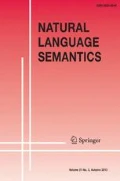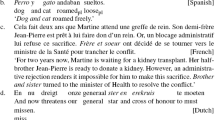Abstract
In this paper, I argue on empirical grounds that (VL-initial) Asymmetric Coordination in German cannot be reduced to a syntactic structure of the form [if S1, then S2], but rather needs to be analyzed as some kind of adjunction to the if-clause, i.e., along the lines of [[if S1] and S2]. This conclusion gives rise to an apparent mismatch between syntactic structure (narrow scope of if) and semantic interpretation (wide scope of if). To resolve this paradoxical situation, I propose a compositional semantics for conditionals that is based on the idea that (indexed) if is to be construed as some kind of anaphor (variable) that ranges over objects of type modal base picking up a modal background in the actual context. Even though this analysis assigns a non-vacuous semantics to the complementizer if, it is still compatible with the syntax of Asymmetric Coordination in German, and, in contrast to alternative accounts, avoids the generation of non-existent distributive readings.
Similar content being viewed by others
References
Bhatt, R., and R. Pancheva. 2006. Conditionals. In The Blackwell companion to syntax, vol. 1, Blackwell Handbooks in Linguistics, ed. M. Everaert and H. van Riemsdijk, 638–687. Oxford: Blackwell Publishing.
Büring D., Hartmann K. (1998) Asymmetrische Koordination. Linguistische Berichte 174: 172–201
Fortmann C. (2005) Die Lücken im Bild von der Subjektlücken-Konstruktion. Linguistische Berichte 204: 441–476
Frank, A. 2002. A (discourse) functional analysis of asymmetric coordination. In Proceedings of the LFG02 Conference, ed. M. Butt and T. King, 174–196.
Heim I., Kratzer A. (1998) Semantics in generative grammar. Blackwell, Oxford
Heycock C., Kroch A. (1994) Verb movement and coordination in a dynamic theory of licensing. The Linguistic Review 11: 257–284
Höhle, T. N. 1983. Subjektlücken in Koordinationen. Ms., Tübingen.
Höhle, T. N. 1990. Assumptions about asymmetric coordination in German. In Grammar in progress. GLOW Essays for Henk van Riemsdijk, ed. J. Mascaró and M. Nespor, 221–235. Dordrecht: Foris.
Iatridou, S. 1991. Topics in conditionals. Ph.D. thesis, MIT, Cambridge, MA.
Johnson K. (2002) Restoring exotic coordinations to normalcy. Linguistic Inquiry 33: 97–156
Kehler A. (2002) Coherence, reference, and the theory of grammar. CSLI, Stanford, California
König, E., and J. van der Auwera. 1988. Clause integration in German and Dutch conditionals, concessive conditionals, and concessives. In Clause combining in grammar and discourse, ed. J. Haiman and S. A. Thompson, 101–133. Amsterdam: John Benjamins
Kratzer, A. 1991a. ‘Conditionals’. In Semantik—Ein internationales Handbuch zeitgenössischer Forschung. (Semantics—An international handbook of contemporary research), ed. A. von Stechow and D. Wunderlich, 651–656. Berlin: Gruyter.
Kratzer, A. 1991b. ‘Modality’. In Semantik—Ein internationales Handbuch zeitgenössischer Forschung. (Semantics—An international handbook of contemporary research), ed. A. von Stechow and D. Wunderlich, 639–650. Berlin: Gruyter.
Kratzer A. (1998) ‘Scope or pseudoscope? Are there wide-scope indefinites?’. In: Rothstein S. (eds) Events and grammar. Kluwer, Dordrecht, pp 163–196
Postal P.M. (1998) Three investigations of extraction. MIT Press, Cambridge, MA.
Reich, I. 2007. Asymmetrische Koordination im Deutschen. Habilitationsschrift, Universität Tübingen, Tübingen.
Reich, I. 2008. From discourse to ‘odd coordinations’—on asymmetric coordination and subject gaps in German. In ‘Subordination’ vs. ‘coordination’ in sentence and text, ed. C. Fabricius-Hansen and W. Ramm, 281–303. Amsterdam: John Benjamins
Reinhart T. (1997) Quantifier scope: How labor is divided between QR and choice functions. Linguistics and Philosophy 20: 335–397
Reis, M. 1993. Satzfügung und kommunikative Gewichtung: Zur Grammatik und Pragmatik von Neben- vs. Unterordnung am Beispiel ‘implikativer’ und-Konstruktionen im Deutschen. In Wortstellung und Informationsstruktur, ed. M. Reis, 203–249. Tübingen: Niemeyer.
Rooth, M., and B. Partee. 1982. Conjunction, type ambiguity, and wide scope ‘or’. Proceedings of the 1st west coast conference on formal linguistics. Stanford, California, pp. 353–362.
Ross, J. R. 1967. Constraints on variables in syntax. Ph.D. thesis, MIT, Cambridge, MA.
Schlenker P. (2004) Conditionals as definite descriptions (a referential analysis). Research on Language and Computation 1: 417–462
Sternefeld W. (2006) Syntax. Eine morphologisch motivierte generative Beschreibung des Deutschen. Band 2. Stauffenburg, Tübingen.
te Velde, J. R. 2006. Deriving coordinate symmetries: A phase-based approach integrating select, merge, copy and match, vol. 89 of Linguistik Aktuell/Linguistics Today. Ansterdam: John Benjamins.
Truckenbrodt H. (2006) On the semantic motivation of syntactic verb movement to C. Theoretical Linguistics 32: 257–306
Von Fintel, K. 1994. Restrictions on quantifier domains. Ph.D. thesis, University of Massachusetts, Amherst.
Von Stechow, A. 2004. Schritte zur Satzsemantik. Ms., Tübingen.
Wunderlich, D. 1988. Some problems of coordination in German. In Natural language parsing and linguistic theories, vol. 35 of Studies in Linguistics and Philosophy, ed. U. Reyle and C. Rohrer, 289–316. Dordrecht: Reidel.
Author information
Authors and Affiliations
Corresponding author
Rights and permissions
About this article
Cite this article
Reich, I. What Asymmetric Coordination in German tells us about the syntax and semantics of conditionals. Nat Lang Semantics 17, 219–244 (2009). https://doi.org/10.1007/s11050-009-9041-y
Published:
Issue Date:
DOI: https://doi.org/10.1007/s11050-009-9041-y




